Analysis of Welfare Law and the Court System: Kogarah Local Court Case
VerifiedAdded on 2023/06/03
|7
|1796
|407
Report
AI Summary
This report provides an overview of the Australian welfare system and its enforcement through the court system, with a specific focus on the role, structure, and purpose of the Magistrate’s Court, particularly the Kogarah Local Court. It details the court's jurisdiction in handling various legal areas, including criminal charges, civil claims, family disputes, and children's matters. The report includes an actual case observed at Kogarah Local Court involving a child custody dispute, highlighting ethical considerations in welfare law matters, such as the best interests of the child, harm and benefits, informed consent, and privacy. It also outlines the dispute resolution process within the local court, emphasizing the magistrate's role in making decisions based on the presented evidence and the right to appeal. The report references various scholarly articles to support its analysis of welfare law and the court system.
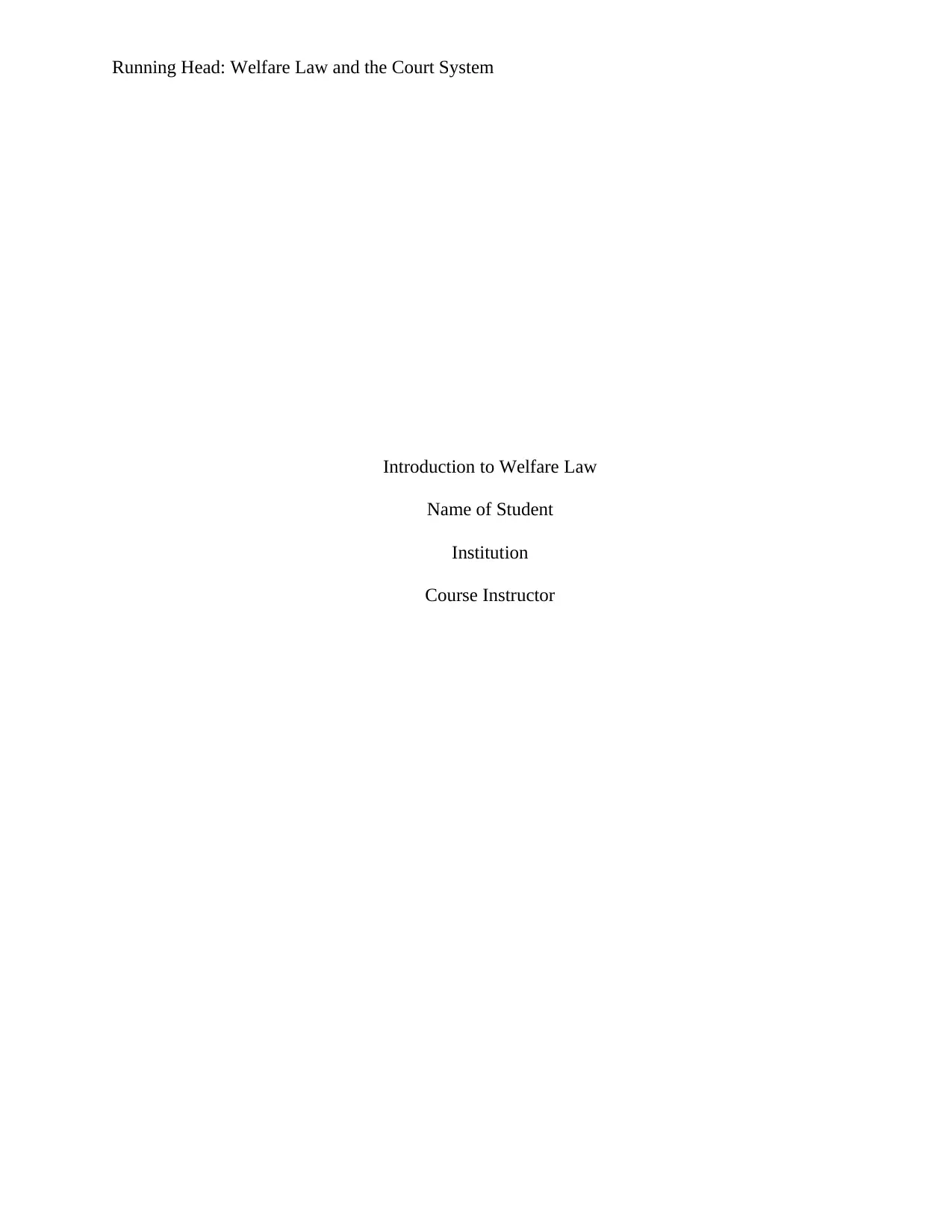
Running Head: Welfare Law and the Court System
Introduction to Welfare Law
Name of Student
Institution
Course Instructor
Introduction to Welfare Law
Name of Student
Institution
Course Instructor
Paraphrase This Document
Need a fresh take? Get an instant paraphrase of this document with our AI Paraphraser
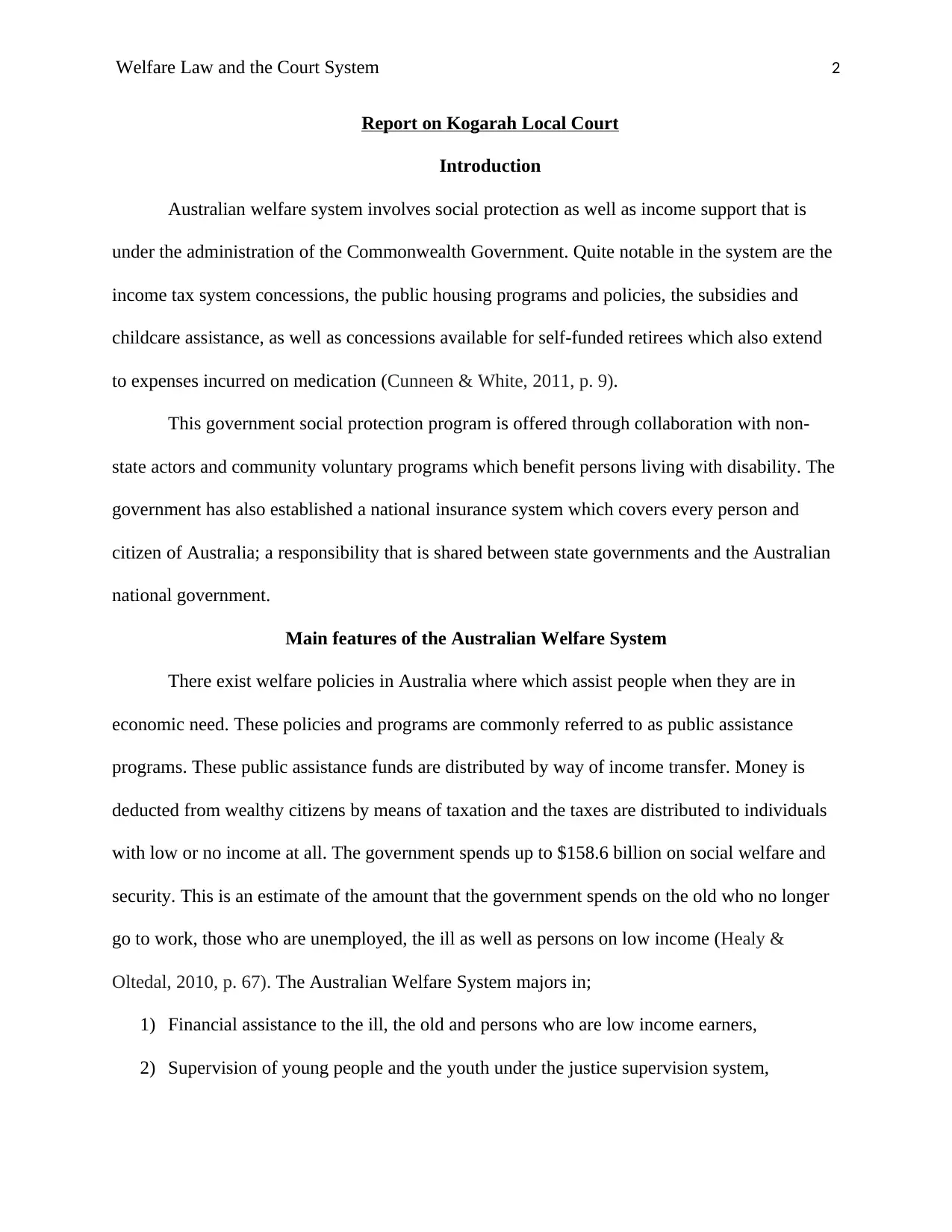
Welfare Law and the Court System 2
Report on Kogarah Local Court
Introduction
Australian welfare system involves social protection as well as income support that is
under the administration of the Commonwealth Government. Quite notable in the system are the
income tax system concessions, the public housing programs and policies, the subsidies and
childcare assistance, as well as concessions available for self-funded retirees which also extend
to expenses incurred on medication (Cunneen & White, 2011, p. 9).
This government social protection program is offered through collaboration with non-
state actors and community voluntary programs which benefit persons living with disability. The
government has also established a national insurance system which covers every person and
citizen of Australia; a responsibility that is shared between state governments and the Australian
national government.
Main features of the Australian Welfare System
There exist welfare policies in Australia where which assist people when they are in
economic need. These policies and programs are commonly referred to as public assistance
programs. These public assistance funds are distributed by way of income transfer. Money is
deducted from wealthy citizens by means of taxation and the taxes are distributed to individuals
with low or no income at all. The government spends up to $158.6 billion on social welfare and
security. This is an estimate of the amount that the government spends on the old who no longer
go to work, those who are unemployed, the ill as well as persons on low income (Healy &
Oltedal, 2010, p. 67). The Australian Welfare System majors in;
1) Financial assistance to the ill, the old and persons who are low income earners,
2) Supervision of young people and the youth under the justice supervision system,
Report on Kogarah Local Court
Introduction
Australian welfare system involves social protection as well as income support that is
under the administration of the Commonwealth Government. Quite notable in the system are the
income tax system concessions, the public housing programs and policies, the subsidies and
childcare assistance, as well as concessions available for self-funded retirees which also extend
to expenses incurred on medication (Cunneen & White, 2011, p. 9).
This government social protection program is offered through collaboration with non-
state actors and community voluntary programs which benefit persons living with disability. The
government has also established a national insurance system which covers every person and
citizen of Australia; a responsibility that is shared between state governments and the Australian
national government.
Main features of the Australian Welfare System
There exist welfare policies in Australia where which assist people when they are in
economic need. These policies and programs are commonly referred to as public assistance
programs. These public assistance funds are distributed by way of income transfer. Money is
deducted from wealthy citizens by means of taxation and the taxes are distributed to individuals
with low or no income at all. The government spends up to $158.6 billion on social welfare and
security. This is an estimate of the amount that the government spends on the old who no longer
go to work, those who are unemployed, the ill as well as persons on low income (Healy &
Oltedal, 2010, p. 67). The Australian Welfare System majors in;
1) Financial assistance to the ill, the old and persons who are low income earners,
2) Supervision of young people and the youth under the justice supervision system,
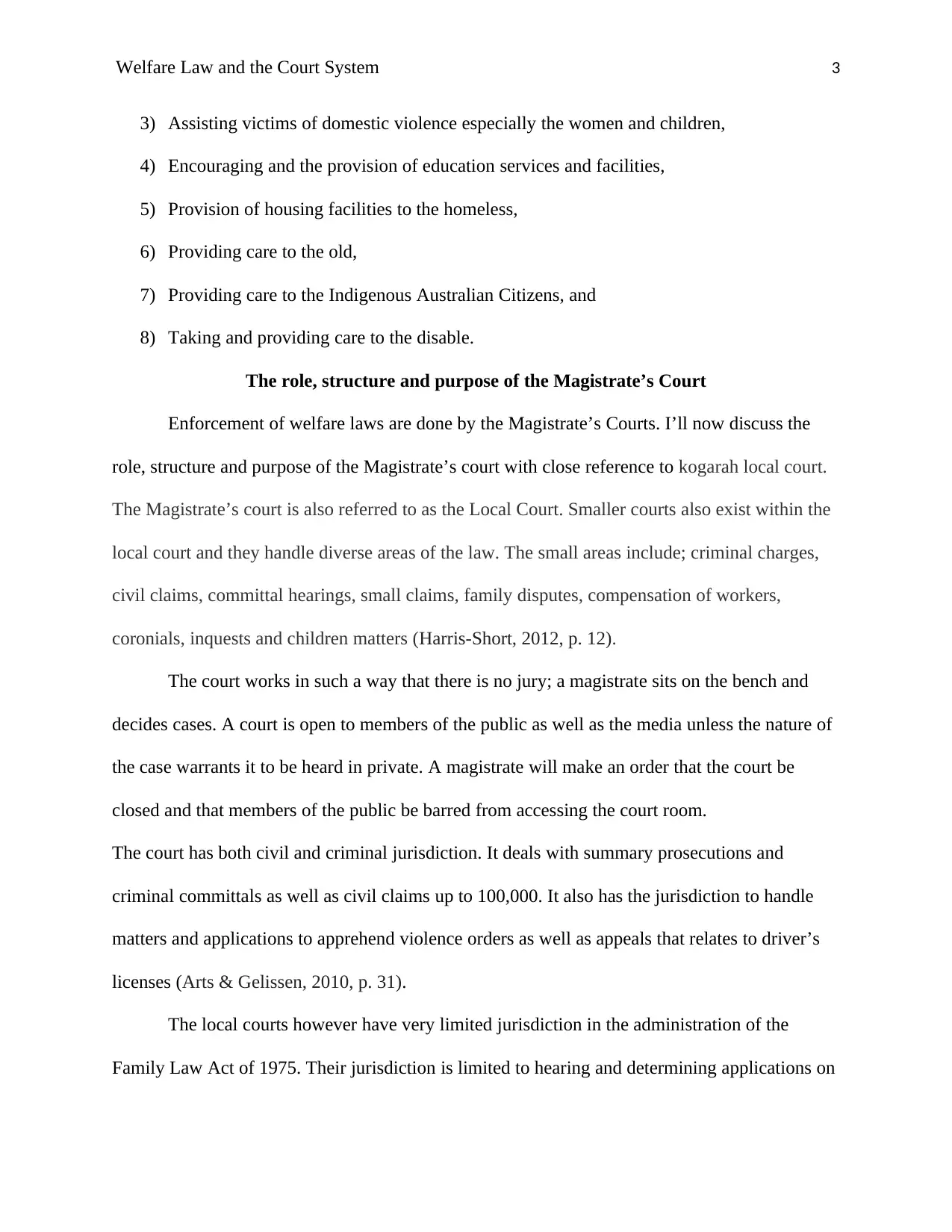
Welfare Law and the Court System 3
3) Assisting victims of domestic violence especially the women and children,
4) Encouraging and the provision of education services and facilities,
5) Provision of housing facilities to the homeless,
6) Providing care to the old,
7) Providing care to the Indigenous Australian Citizens, and
8) Taking and providing care to the disable.
The role, structure and purpose of the Magistrate’s Court
Enforcement of welfare laws are done by the Magistrate’s Courts. I’ll now discuss the
role, structure and purpose of the Magistrate’s court with close reference to kogarah local court.
The Magistrate’s court is also referred to as the Local Court. Smaller courts also exist within the
local court and they handle diverse areas of the law. The small areas include; criminal charges,
civil claims, committal hearings, small claims, family disputes, compensation of workers,
coronials, inquests and children matters (Harris-Short, 2012, p. 12).
The court works in such a way that there is no jury; a magistrate sits on the bench and
decides cases. A court is open to members of the public as well as the media unless the nature of
the case warrants it to be heard in private. A magistrate will make an order that the court be
closed and that members of the public be barred from accessing the court room.
The court has both civil and criminal jurisdiction. It deals with summary prosecutions and
criminal committals as well as civil claims up to 100,000. It also has the jurisdiction to handle
matters and applications to apprehend violence orders as well as appeals that relates to driver’s
licenses (Arts & Gelissen, 2010, p. 31).
The local courts however have very limited jurisdiction in the administration of the
Family Law Act of 1975. Their jurisdiction is limited to hearing and determining applications on
3) Assisting victims of domestic violence especially the women and children,
4) Encouraging and the provision of education services and facilities,
5) Provision of housing facilities to the homeless,
6) Providing care to the old,
7) Providing care to the Indigenous Australian Citizens, and
8) Taking and providing care to the disable.
The role, structure and purpose of the Magistrate’s Court
Enforcement of welfare laws are done by the Magistrate’s Courts. I’ll now discuss the
role, structure and purpose of the Magistrate’s court with close reference to kogarah local court.
The Magistrate’s court is also referred to as the Local Court. Smaller courts also exist within the
local court and they handle diverse areas of the law. The small areas include; criminal charges,
civil claims, committal hearings, small claims, family disputes, compensation of workers,
coronials, inquests and children matters (Harris-Short, 2012, p. 12).
The court works in such a way that there is no jury; a magistrate sits on the bench and
decides cases. A court is open to members of the public as well as the media unless the nature of
the case warrants it to be heard in private. A magistrate will make an order that the court be
closed and that members of the public be barred from accessing the court room.
The court has both civil and criminal jurisdiction. It deals with summary prosecutions and
criminal committals as well as civil claims up to 100,000. It also has the jurisdiction to handle
matters and applications to apprehend violence orders as well as appeals that relates to driver’s
licenses (Arts & Gelissen, 2010, p. 31).
The local courts however have very limited jurisdiction in the administration of the
Family Law Act of 1975. Their jurisdiction is limited to hearing and determining applications on
⊘ This is a preview!⊘
Do you want full access?
Subscribe today to unlock all pages.

Trusted by 1+ million students worldwide
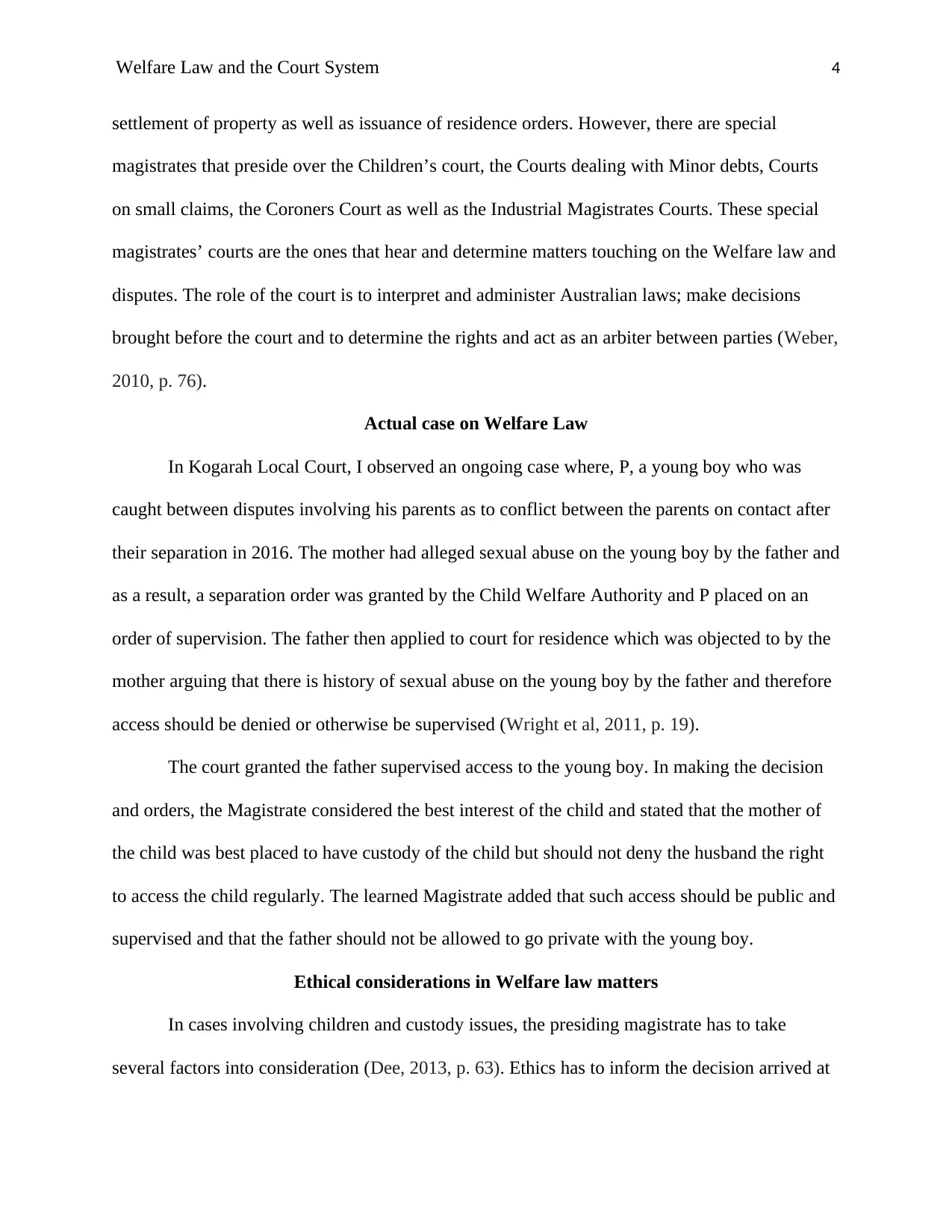
Welfare Law and the Court System 4
settlement of property as well as issuance of residence orders. However, there are special
magistrates that preside over the Children’s court, the Courts dealing with Minor debts, Courts
on small claims, the Coroners Court as well as the Industrial Magistrates Courts. These special
magistrates’ courts are the ones that hear and determine matters touching on the Welfare law and
disputes. The role of the court is to interpret and administer Australian laws; make decisions
brought before the court and to determine the rights and act as an arbiter between parties (Weber,
2010, p. 76).
Actual case on Welfare Law
In Kogarah Local Court, I observed an ongoing case where, P, a young boy who was
caught between disputes involving his parents as to conflict between the parents on contact after
their separation in 2016. The mother had alleged sexual abuse on the young boy by the father and
as a result, a separation order was granted by the Child Welfare Authority and P placed on an
order of supervision. The father then applied to court for residence which was objected to by the
mother arguing that there is history of sexual abuse on the young boy by the father and therefore
access should be denied or otherwise be supervised (Wright et al, 2011, p. 19).
The court granted the father supervised access to the young boy. In making the decision
and orders, the Magistrate considered the best interest of the child and stated that the mother of
the child was best placed to have custody of the child but should not deny the husband the right
to access the child regularly. The learned Magistrate added that such access should be public and
supervised and that the father should not be allowed to go private with the young boy.
Ethical considerations in Welfare law matters
In cases involving children and custody issues, the presiding magistrate has to take
several factors into consideration (Dee, 2013, p. 63). Ethics has to inform the decision arrived at
settlement of property as well as issuance of residence orders. However, there are special
magistrates that preside over the Children’s court, the Courts dealing with Minor debts, Courts
on small claims, the Coroners Court as well as the Industrial Magistrates Courts. These special
magistrates’ courts are the ones that hear and determine matters touching on the Welfare law and
disputes. The role of the court is to interpret and administer Australian laws; make decisions
brought before the court and to determine the rights and act as an arbiter between parties (Weber,
2010, p. 76).
Actual case on Welfare Law
In Kogarah Local Court, I observed an ongoing case where, P, a young boy who was
caught between disputes involving his parents as to conflict between the parents on contact after
their separation in 2016. The mother had alleged sexual abuse on the young boy by the father and
as a result, a separation order was granted by the Child Welfare Authority and P placed on an
order of supervision. The father then applied to court for residence which was objected to by the
mother arguing that there is history of sexual abuse on the young boy by the father and therefore
access should be denied or otherwise be supervised (Wright et al, 2011, p. 19).
The court granted the father supervised access to the young boy. In making the decision
and orders, the Magistrate considered the best interest of the child and stated that the mother of
the child was best placed to have custody of the child but should not deny the husband the right
to access the child regularly. The learned Magistrate added that such access should be public and
supervised and that the father should not be allowed to go private with the young boy.
Ethical considerations in Welfare law matters
In cases involving children and custody issues, the presiding magistrate has to take
several factors into consideration (Dee, 2013, p. 63). Ethics has to inform the decision arrived at
Paraphrase This Document
Need a fresh take? Get an instant paraphrase of this document with our AI Paraphraser
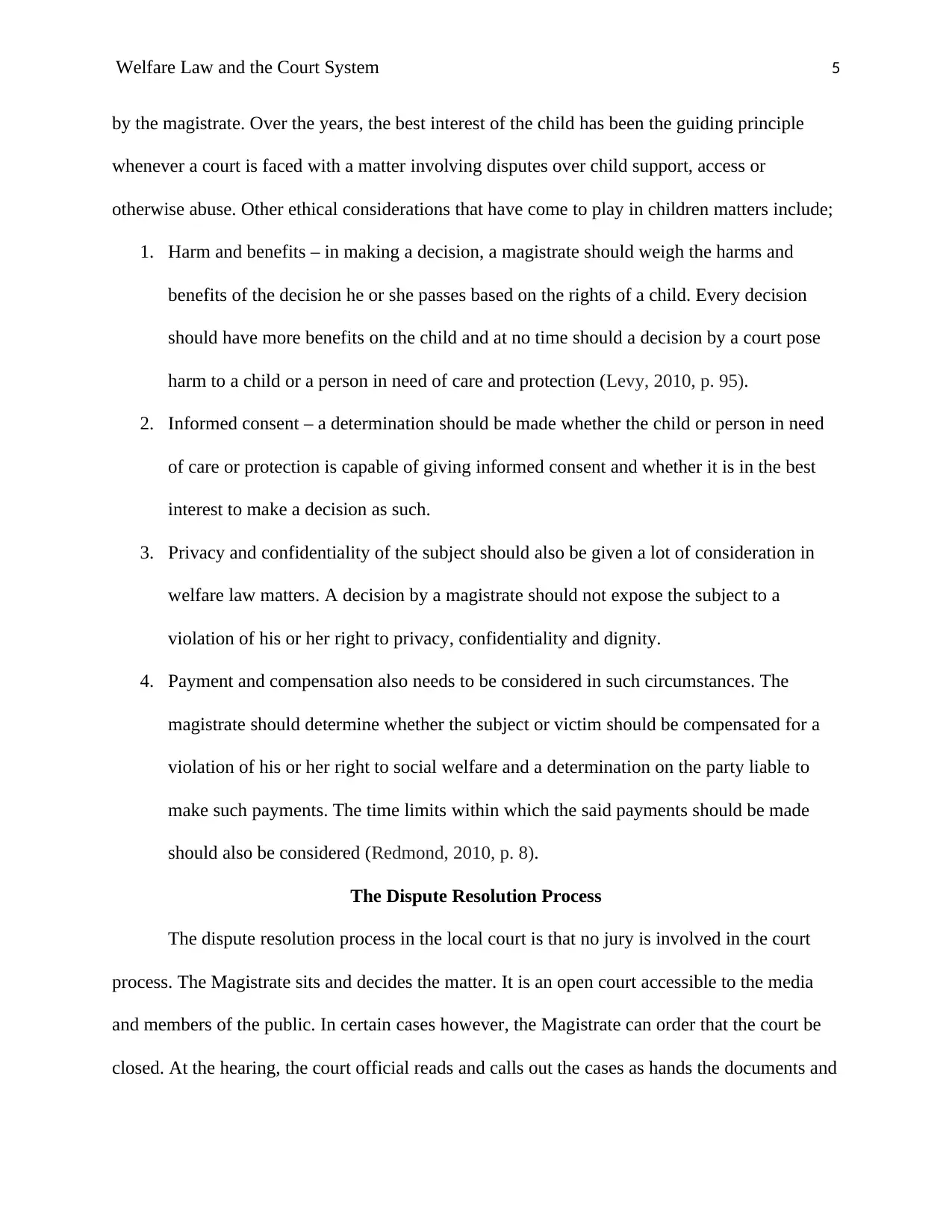
Welfare Law and the Court System 5
by the magistrate. Over the years, the best interest of the child has been the guiding principle
whenever a court is faced with a matter involving disputes over child support, access or
otherwise abuse. Other ethical considerations that have come to play in children matters include;
1. Harm and benefits – in making a decision, a magistrate should weigh the harms and
benefits of the decision he or she passes based on the rights of a child. Every decision
should have more benefits on the child and at no time should a decision by a court pose
harm to a child or a person in need of care and protection (Levy, 2010, p. 95).
2. Informed consent – a determination should be made whether the child or person in need
of care or protection is capable of giving informed consent and whether it is in the best
interest to make a decision as such.
3. Privacy and confidentiality of the subject should also be given a lot of consideration in
welfare law matters. A decision by a magistrate should not expose the subject to a
violation of his or her right to privacy, confidentiality and dignity.
4. Payment and compensation also needs to be considered in such circumstances. The
magistrate should determine whether the subject or victim should be compensated for a
violation of his or her right to social welfare and a determination on the party liable to
make such payments. The time limits within which the said payments should be made
should also be considered (Redmond, 2010, p. 8).
The Dispute Resolution Process
The dispute resolution process in the local court is that no jury is involved in the court
process. The Magistrate sits and decides the matter. It is an open court accessible to the media
and members of the public. In certain cases however, the Magistrate can order that the court be
closed. At the hearing, the court official reads and calls out the cases as hands the documents and
by the magistrate. Over the years, the best interest of the child has been the guiding principle
whenever a court is faced with a matter involving disputes over child support, access or
otherwise abuse. Other ethical considerations that have come to play in children matters include;
1. Harm and benefits – in making a decision, a magistrate should weigh the harms and
benefits of the decision he or she passes based on the rights of a child. Every decision
should have more benefits on the child and at no time should a decision by a court pose
harm to a child or a person in need of care and protection (Levy, 2010, p. 95).
2. Informed consent – a determination should be made whether the child or person in need
of care or protection is capable of giving informed consent and whether it is in the best
interest to make a decision as such.
3. Privacy and confidentiality of the subject should also be given a lot of consideration in
welfare law matters. A decision by a magistrate should not expose the subject to a
violation of his or her right to privacy, confidentiality and dignity.
4. Payment and compensation also needs to be considered in such circumstances. The
magistrate should determine whether the subject or victim should be compensated for a
violation of his or her right to social welfare and a determination on the party liable to
make such payments. The time limits within which the said payments should be made
should also be considered (Redmond, 2010, p. 8).
The Dispute Resolution Process
The dispute resolution process in the local court is that no jury is involved in the court
process. The Magistrate sits and decides the matter. It is an open court accessible to the media
and members of the public. In certain cases however, the Magistrate can order that the court be
closed. At the hearing, the court official reads and calls out the cases as hands the documents and
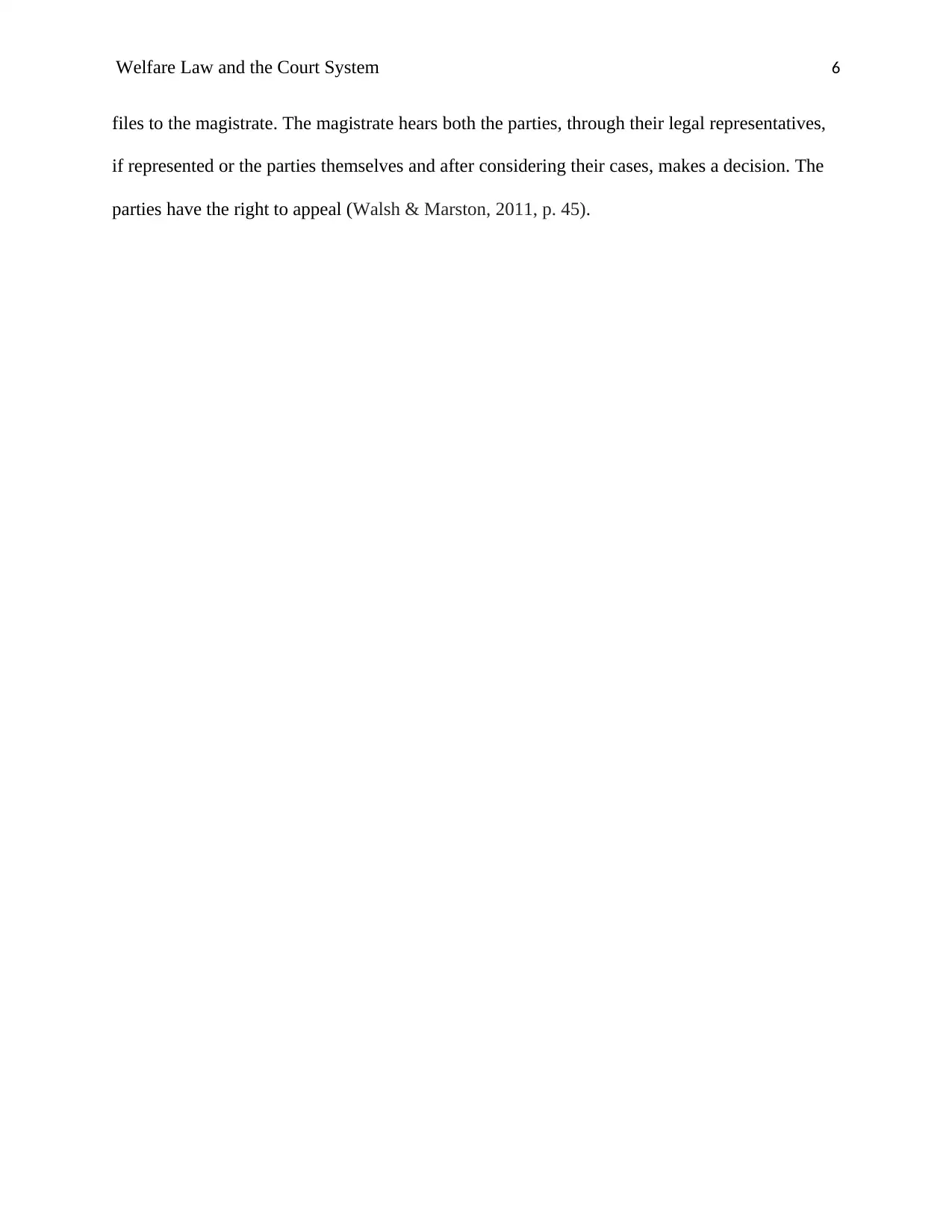
Welfare Law and the Court System 6
files to the magistrate. The magistrate hears both the parties, through their legal representatives,
if represented or the parties themselves and after considering their cases, makes a decision. The
parties have the right to appeal (Walsh & Marston, 2011, p. 45).
files to the magistrate. The magistrate hears both the parties, through their legal representatives,
if represented or the parties themselves and after considering their cases, makes a decision. The
parties have the right to appeal (Walsh & Marston, 2011, p. 45).
⊘ This is a preview!⊘
Do you want full access?
Subscribe today to unlock all pages.

Trusted by 1+ million students worldwide
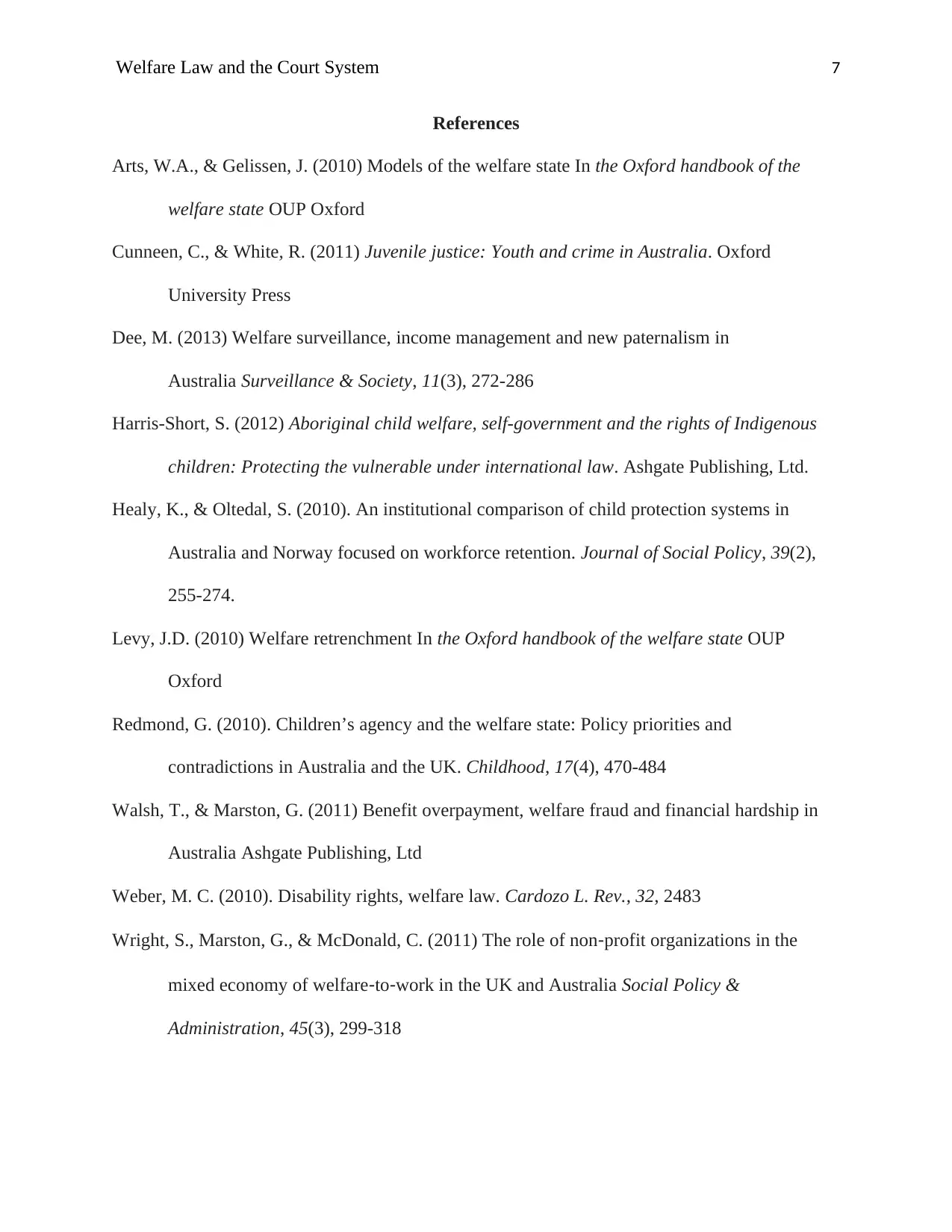
Welfare Law and the Court System 7
References
Arts, W.A., & Gelissen, J. (2010) Models of the welfare state In the Oxford handbook of the
welfare state OUP Oxford
Cunneen, C., & White, R. (2011) Juvenile justice: Youth and crime in Australia. Oxford
University Press
Dee, M. (2013) Welfare surveillance, income management and new paternalism in
Australia Surveillance & Society, 11(3), 272-286
Harris-Short, S. (2012) Aboriginal child welfare, self-government and the rights of Indigenous
children: Protecting the vulnerable under international law. Ashgate Publishing, Ltd.
Healy, K., & Oltedal, S. (2010). An institutional comparison of child protection systems in
Australia and Norway focused on workforce retention. Journal of Social Policy, 39(2),
255-274.
Levy, J.D. (2010) Welfare retrenchment In the Oxford handbook of the welfare state OUP
Oxford
Redmond, G. (2010). Children’s agency and the welfare state: Policy priorities and
contradictions in Australia and the UK. Childhood, 17(4), 470-484
Walsh, T., & Marston, G. (2011) Benefit overpayment, welfare fraud and financial hardship in
Australia Ashgate Publishing, Ltd
Weber, M. C. (2010). Disability rights, welfare law. Cardozo L. Rev., 32, 2483
Wright, S., Marston, G., & McDonald, C. (2011) The role of non‐profit organizations in the
mixed economy of welfare‐to‐work in the UK and Australia Social Policy &
Administration, 45(3), 299-318
References
Arts, W.A., & Gelissen, J. (2010) Models of the welfare state In the Oxford handbook of the
welfare state OUP Oxford
Cunneen, C., & White, R. (2011) Juvenile justice: Youth and crime in Australia. Oxford
University Press
Dee, M. (2013) Welfare surveillance, income management and new paternalism in
Australia Surveillance & Society, 11(3), 272-286
Harris-Short, S. (2012) Aboriginal child welfare, self-government and the rights of Indigenous
children: Protecting the vulnerable under international law. Ashgate Publishing, Ltd.
Healy, K., & Oltedal, S. (2010). An institutional comparison of child protection systems in
Australia and Norway focused on workforce retention. Journal of Social Policy, 39(2),
255-274.
Levy, J.D. (2010) Welfare retrenchment In the Oxford handbook of the welfare state OUP
Oxford
Redmond, G. (2010). Children’s agency and the welfare state: Policy priorities and
contradictions in Australia and the UK. Childhood, 17(4), 470-484
Walsh, T., & Marston, G. (2011) Benefit overpayment, welfare fraud and financial hardship in
Australia Ashgate Publishing, Ltd
Weber, M. C. (2010). Disability rights, welfare law. Cardozo L. Rev., 32, 2483
Wright, S., Marston, G., & McDonald, C. (2011) The role of non‐profit organizations in the
mixed economy of welfare‐to‐work in the UK and Australia Social Policy &
Administration, 45(3), 299-318
1 out of 7
Related Documents
Your All-in-One AI-Powered Toolkit for Academic Success.
+13062052269
info@desklib.com
Available 24*7 on WhatsApp / Email
![[object Object]](/_next/static/media/star-bottom.7253800d.svg)
Unlock your academic potential
Copyright © 2020–2025 A2Z Services. All Rights Reserved. Developed and managed by ZUCOL.




